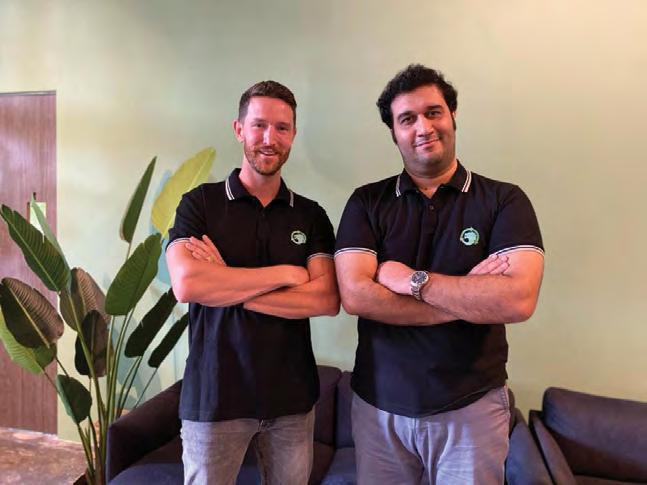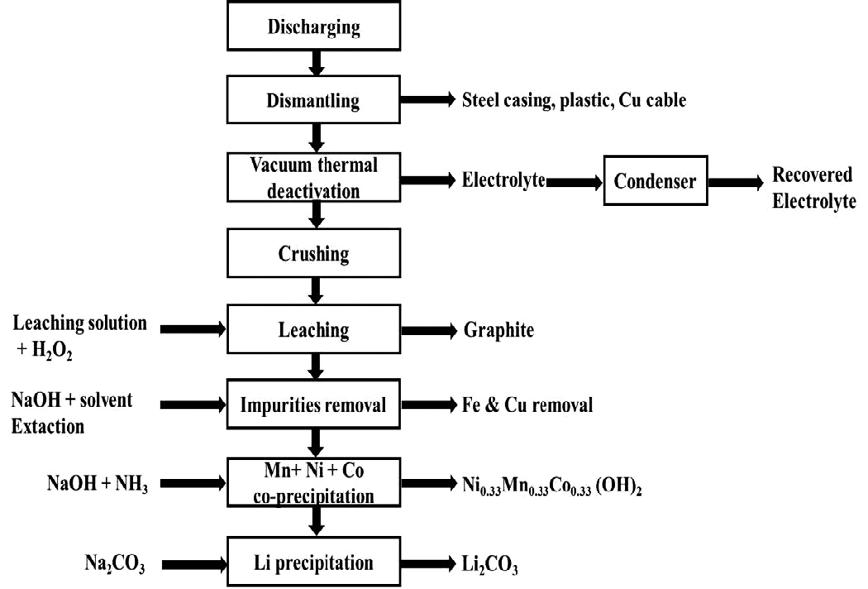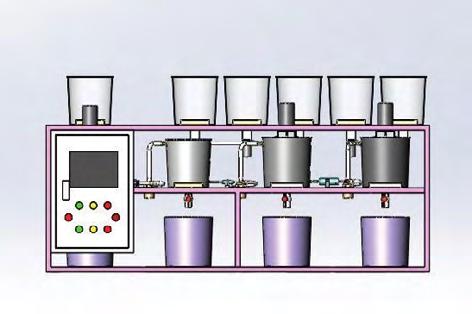
8 minute read
Lithium-ion battery rejuvenation technology solution created in Singapore Bringing batteries back to life supports the circular economy
LITHIUM-ION BATTERY REJUVENATION TECHNOLOGY SOLUTION CREATED IN SINGAPORE
Bringing batteries back to life supports the circular economy.
Lithium-ion batteries (LIBs) are now the world’s preferred source of portable energy, but the sad reality is that, with a functional lifespan of only one to three years, up to 95% of these batteries soon end up as e-waste in landfills. Singapore generates about 60,000 t of e-waste a year. Waste disposal is a major challenge for Singapore, with the only landfill for incinerated waste, at Pulau Semakau, expected to run out of space by 2035. In an attempt to curb this worrying trend, the Ministry of Sustainability and the Environment (MSE), formerly the Ministry of Environment and Water Resources (MEWR), and National Environment Agency (NEA) have introduced an Extended Producer Responsibility (EPR) framework for e-waste, which takes effect in just six months, starting from 2021. The EPR deadlines mean that local electronics producers will now have to take on the responsibility for the collection and proper treatment of e-waste, but current LIB recycling options are not economically viable, resulting in a dismal 5% recycling rate. However, two dedicated environmentalists, Leon Farrant and Dr Reza Katal, who spent over a decade perfecting a solution, have now set up Green Li-ion, a greentech startup in Singapore, with the former as CEO and the latter as CTO. With their combined expertise in chemical and environmental engineering, the two co-founders developed a system comprising a patented multi-cathode processor and control unit, GLMC-1. The system is said to represent the world’s most advanced LIB rejuvenation technology.
The technology
GLMC-1’s technology is based on a co-precipitation sequence and control system which can process various types of spent (used) LIBs, while current technologies are said to enable processing of only a single type of LIB. The co-precipitation method allows the recovery of cathode metal salts in their original form, without separation of the metal elements, speeding up the recycling process by two to three times. The metal salts obtained will then serve as the precursor for the synthesis of new cathode material which will form the basis for new LIBs, thereby closing the loop and contributing to a circular energy economy. The technology can be applied to enhance existing LIB recycling processes to increase purity and profitability, but can also serve as a stand-alone system for recycling and cathode manufacturing.
From left, Mr Leon Farrant, CEO, and Dr Reza Katal, CTO, Green Li-ion.
The new technology is said to offer several advantages.
Environment-friendliness
The technology generates zero waste materials and there are no heavy metal discharges into the environment. It helps to save approximately 5 tonnes of CO2 emissions per tonne of precious metals or cathode materials extracted, compared to the CO2 emissions due to mining and processing to get the same quantity of the materials.
Speed
It takes only 10 to 14 hours to process 1 tonne of LIBs into the end product - a cathode. GLMC-1 simply plugs in to the end of the current recycling processes, takes in ‘black mass’ to separate out precious metals and re-engineers these raw materials into a usable cathode which forms part of a new functional LIB.
Higher yield
The technology enables the production of 99.9% pure cathodes. The process recovers the following products at more than 99% purity levels: • •
Graphite
Cathode metal salts, e.g. LiCo1/3Ni1/3Mn1/3O2, NiCO3,
MnCO3, CoC2O4, and Li2CO3
Increased efficiency
Green Li-ion’s co-precipitation method avoids separation of the cathode metal elements, saving cost and reduces processing steps, thereby increasing recycling efficiency by over 200%.

Schematic showing the various processing stages defining Green Li-ion’s LIB rejuvenation technology.
Wider range of materials handled
The technology has the ability to sort and process all major variations of LIBs such as lithium cobalt oxide (LCO), lithium manganese oxide (LMO), lithium nickel manganese cobalt oxide (NMC) and lithium nickel cobalt aluminium oxide (NCA).
Increased economic viability
Profits from LIB recycling, using this technology, are said to be four times greater than profits made using current technologies, as various types of LIBs can be processed and valuable cathode precursors can be synthesised.
COMMERCIALISATION OF THE TECHNOLOGY
To date, Green Li-ion has raised USD 400,000 in pre-seed funding, graduating with the highest funding amount in its Entrepreneur First Singapore 2020 cohort of 10 companies, despite the global pandemic and economic downturn. One of the first investors is HAX, the US- and China-based hardware startup accelerator that is owned by SOSV. Recently, Green Li-ion signed heads of agreement on a large seed funding round. Professor Seeram Ramakrishna, Chair of the Circular Economy Task Force at the National University of Singapore, serves on Green Li-ion’s Advisory Board. With extensive institutional and industry support, Green Li-ion’s first GLMC-1 is expected to begin operations soon and the second GLMC-1 is expected to be operational in
A rendering of GLMC-1, Green Li-ion’s patented multi-cathode processor and control unit.

January 2021. Green Li-ion is currently in talks with all six of Singapore’s main e-waste recycling companies and major global e-recycling players in Dubai and China, to supply GLMC-1 units to their facilities. All these e-recyclers have confirmed the novelty and transformative potential of Green Li-ion’s technology which is protected by four patents. As the circular economy becomes increasingly crucial and the end-of-life legislation starts to impact battery manufacturers, the purity and efficiency of LIB recycling will be key to sustainability. The environmental, social and economic impact of Green Li-ion’s technology on the energy industry are expected to be significant.
Innovative technology receives enthusiastic reception
Mr Leon Farrant CEO, Green Li-ion, provides more information on the GLMC-1.
Question: How big is the GLMC-1 equipment? How much area does it occupy and what is its capacity?
Answer: The equipment occupies 80 m2. Each machine can recycle up to 728 tonnes per year or 2 tonnes per day if running on a 24-hour shift.
Q: How much energy, water and other resources are required for the GLMC-1 process?
A: There is a chemical and metals requirement for the processing of 1 tonne of lithium ion batteries, which changes according to the different battery types as the input. So this is hard to comment on. However, I can say that the water and energy consumption is not high and the carbon footprint is very low, given that it is mainly a chemical process, as opposed to a mechanical or heat induced process.
Q: Are there any effluents produced?
A: We have zero environmentally damaging discharges. The only discharge is a slightly saline water which meets NEA approvals in Singapore and most counThe lithium-ion battery recycling market is growing on account of the limited availability of lithium metal and the rising adoption of electric vehicles (EV). As a result, the industry revenue is expected to surge from USD 165.3 million in 2019 at a substantial CAGR (Compound Annual Growth Rate) of 18.3% during 2020 to 2030. In such energy storage devices, the movement of Li ions between the two terminals leads to discharging and charging, depending on the direction of the ion flow. These batteries contain less-toxic material than several others, which is why their recycling is picking up, according to a market research report published by P&S Intelligence. The divisions of the market under segmentation by end-user are power, automotive, electrical & electronics, and others. Among these, the largest share in the industry in 2019 was held by the automotive division. Recycled material is now being used in the production of batteries, because the availability of lithium metal is limited and because the mining of lithium causes chemicals to spill into and pollute waterbodies. With the burgeoning adoption of EVs, due to the environmental degradation caused by gasoline and diesel vehicles, the demand for batteries, their tries that we would deploy the machine in, if not all. The machine offers a closed loop solution and we use all heavy metals to reproduce an end product for sale. Any other items, plastics etc, are separated in the process and produced as a singular material item for re-sale.

Mr Leon Farrant
Q: What has been the feedback from local and overseas e-waste recyclers regarding the new technology?
A: We are humbled by the overwhelming response. We have a handful of clients who are putting in pre-orders for our machines in Singapore, Australia and the US. Most of our clients are looking at multiple machines or processing lines per facility. Our really big clients are TES in Singapore and a big client
Lithium-ion battery recycling market to grow
in the US. primary power source and, in turn, the materials that go into them, are rising. A key future opportunity area for market players is the growing electrical & electronics sector, as the Li-ion batteries find widespread usage in tablets, laptops, mobile phones, and several other electronic gadgets. With the expansion of this industry in South Korea, China, Thailand, and India, the demand for Li-ion batteries is rising, and can be leveraged by companies offering such recycled energy storage devices and retrieved materials. Asia-Pacific (APAC) is the largest and fastest-growing lithium-ion battery recycling market, on account of the existence of numerous companies undertaking such tasks in the region, primarily in China. Moreover, the uptake of EVs is increasing quickly in Japan, China, Indonesia, Vietnam, and the Philippines, due to environmental concerns and strong government support. Therefore, to fulfill the demand for lithium and other components and chemicals in such batteries, they are being rapidly recycled in the region. Thus, as the demand for electronic devices and EVs grows, so will lithium-ion battery recycling efforts.









